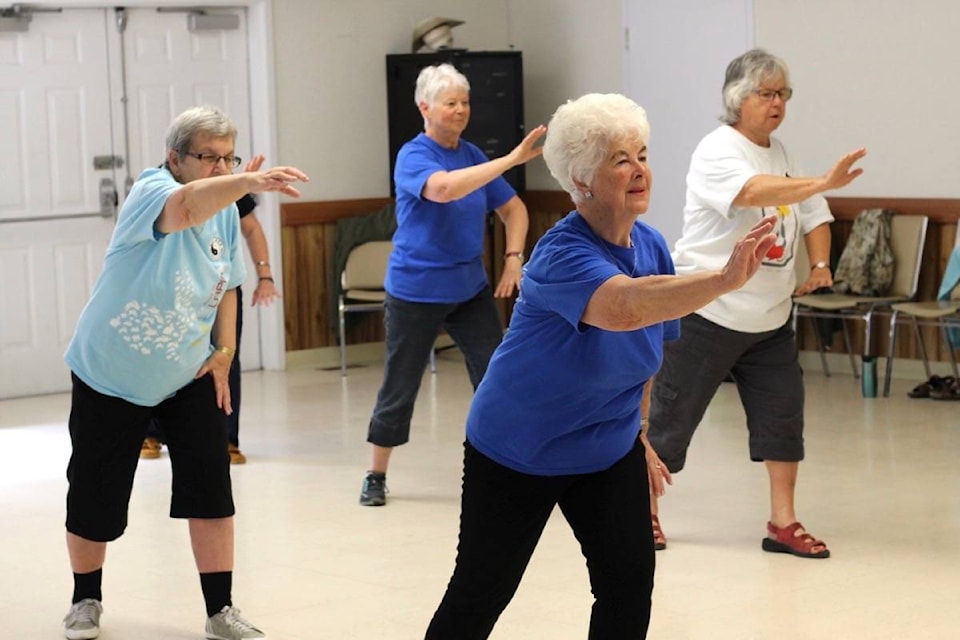In a room at the Creekside Seniors’ Activity Centre, a dozen people move in unison, carefully placing their feet and moving their arms through a series of 108 moves.
They’re practicing tai chi — specifically Fung Loy Lok Taoist Tai Chi — a series of movements designed to improve balance and health.
“You can see it as they move. The spine is opening, stretching. The organs on the inside, because of the stretching, are getting a nice massage and the leg muscles are getting a very gentle workout. Balance is being developed and honed,” says instructor Karen Broughton. She also points to benefits to the brain and circulatory systems.
Each movement, she says, has a connection to the spine.
“You can see how carefully they are stepping, the way they are stepping. This is how we teach how to walk, move and balance, by teaching the movements very specifically. It has to do with the alignment of the bones.”
While Broughton is quick to note that tai chi is for everyone, it is of significant benefit for seniors.
A recent study on tai chi linked the practice to a 20 per cent reduction in risk of falling by seniors as well as a 31 per cent drop in the number of falls. Practicing three times per week resulted in reducing the risk of falling by 64 per cent.
“It’s slow motion, it’s low impact, it can be adapted for anybody,” says instructor-in-training and retired physiotherapist Jacquie Trelenberg. “It’s adapted for any age, any level of fitness, any disability.”
The group even runs a class at the Carefree Manor where residents can practice tai chi while seated.
The practice is described as “moving meditation.” While participants work their way through the movements, they are also concentrating on their breathing and relaxing.
“There’s a flow to it and a feeling,” says Isabelle Ohrling, who began practising tai chi with the group in March.
“No one needs to worry about age because I’m in my 80s and just joined and found it very good because the stretches are gentle and you only do what you can.”
Others have joined the classes because of specific health issues.
“It keeps you moving. It keeps you mobile,” says Roberta Graves, who joined after she lost mobility in her knee due to arthritis.
Gail Orr also joined because of issues she was having with arthritis.
“I was looking for something that would be gentle on my bones,” she says.
While she still has arthritis that is progressing, she says the discomfort from it has lessened.
“I think it helps me live with it.”
While learning the moves was initially challenging, Orr says new members shouldn’t get discouraged.
“It took me a while to get the first moves down even half decently. I have found that every year I go I work on something. Right now I am working on being smoother because I am a person who is very tense.”
The Taoist Tai Chi local chapter runs beginner and continuing classes conjointly at the Creekside Seniors Activity Centre and the 108 Mile Ranch Community Hall from 10 a.m. to 12 p.m. on Mondays and Tuesday’s respectively, but also offers a number of other, more specific classes such as health recovery for those suffering from specific ailments.
The group also appears in the community, sometimes they can be found at the Farmers’ Market welcoming people to join, or at other events around town.
While there is a cost to the lessons that ranges from $175 for adults to $135 for seniors for four months, the contribution covers as many lessons as one wants to take at any location the group operates in, which includes lessons in 25 countries around the world.
The instructors are also continuously improving. Broughton says moves are sometimes adjusted based on the current science about what is best for the body and good health.
The 109th move, as Broughton puts it, is tea. After, and sometimes during the classes, participants take a break between sets and chat with others around them.
Orr points to the camaraderie between everyone in the class, male and female.
“It’s a really nice group and the instructors are very good and very supportive. It’s just a nice way to get exercise.”
